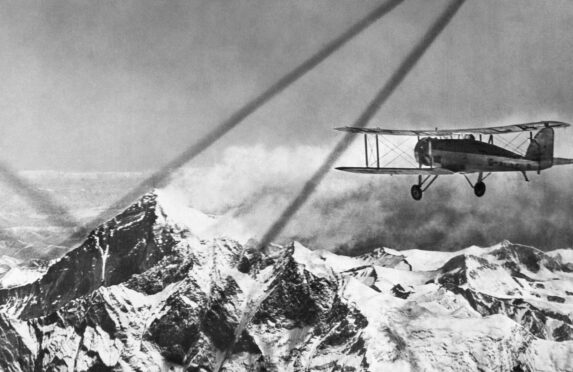
Tom Cruise’s fighter ace might push the aviation envelope in the new Top Gun but, since the dawn of flight, brave pilots have tried to challenge the limits of what is possible.
Many Scots aviators have, of course, been in the cockpit as aviators raced to new heights, from Jim Mollison’s record-breaking flights to Australia and Brazil, to Brian Binnie, the first Scot to reach space in 2004.
Douglas Douglas-Hamilton, 14th Duke of Hamilton, accompanied by fellow Scot David McIntyre, became Scotland’s highest flyer in 1933 thanks to his breathtaking flight over the world’s tallest mountain. Sponsored by philanthropist Dame Fanny Lucy Houston, the Houston–Mount Everest flight expedition was mounted in an attempt to capture images of the ill-fated Mallory-Irvine expedition to scale Everest.
The last action hero: So why is superstar Tom Cruise still flying high as he hits 60?
Hamilton was the natural choice to lead the daring aerial reconnaissance over the Himalayas, being one of the rising stars of the Royal Auxiliary Airforce.
“When he was a schoolboy, he would have seen things like Louis Blériot’s flight across the English Channel and would have been aware of the flying aces of the First World War,” says Michael Oakey, managing editor of The Aviation Historian, who has studied the famous flight. “He had been the RAF’s youngest squadron leader of his day so he was already a bit of a high flyer, so to speak.”
When asked why he wanted to climb Everest, George Mallory had famously replied: “Because it’s there.”
WATCH: Scotland’s first man in space reveals how it feels to gaze at Earth from 264,000 feet
There was a similar motivation for Hamilton, according to Oakey. “Almost every young boy in those days was interested in aviation. For him, it developed into a weekend pursuit. By this stage, the flight over Everest was probably the last pioneering geographic flights. All the main oceans had been crossed, there had been flights from the UK to Australia, someone had flown over the North and South Pole.”
Unlike modern airliners with pressurised cabins, Hamilton and McIntyre had to undertake the trip in prototype Westland Wallace PV-6 biplanes and the pilots were exposed to the atmosphere. “The biggest dangers were altitude and engine failure,” says Oakey.
“The highest altitude they could reach was 33,000ft, just about 3,000ft or 4,000ft above the top of Everest.
“With open cockpits they needed an oxygen supply, oxygen tank and mask. There was the extreme cold, and then there was the risk of engine failure. If the engine stopped then, from where they were, the whole surrounding landscape looked extremely spiky.”
Hamilton and colleagues wore fur-lined clothes, including their flight helmets, and donned gear fitted with electric elements.
As the flight progressed, one of the observers began to experience altitude sickness as his equipment buckled in the extreme freezing temperatures.
“He spotted a hole splitting the oxygen pipe so he had to quickly wrap it up with some cloth to stop the air leaking out,” adds Oakey.
The flight was a success and the photographs provided new images of the summit of Everest. The trip even resulted in an Oscar thanks to the Pathe-style footage.
“The trip resulted in a famous documentary a year after the flight,” says Oakey. “It brilliantly shows all the participants after their gruelling flight had landed, beaming with delight.
“They knew this was a big deal and the difficulties they’d just overcome. There was no guarantee of success but they’d just achieved a truly difficult feat of flying.”

Enjoy the convenience of having The Sunday Post delivered as a digital ePaper straight to your smartphone, tablet or computer.
Subscribe for only £5.49 a month and enjoy all the benefits of the printed paper as a digital replica.
Subscribe